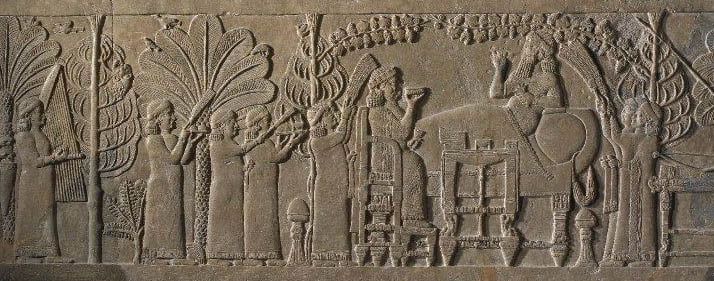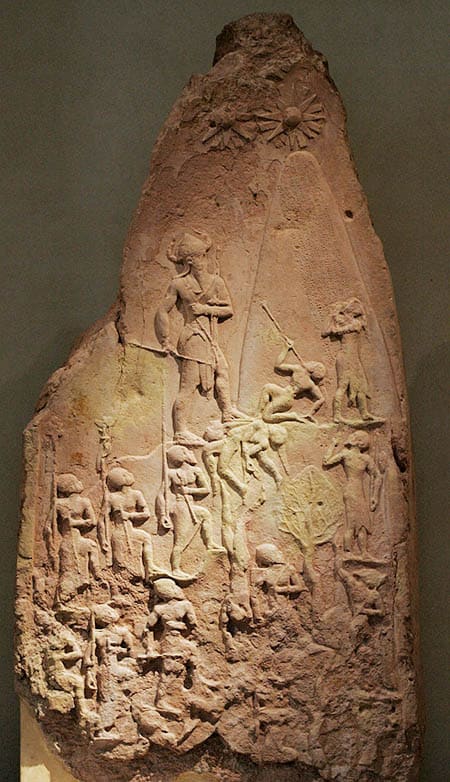
7:Ashurbanipal and His Queen in the Garden
Ashurbanipal was king of the Assyrian Empire from 668 BC to 627 BC, a relatively recent king compared to those we have already mentioned. Actually, if you think just in terms of time, the reign of Ashurbanipal is closer on a timeline to us in today than to the people of Ur 3,200 years ago.
In this frieze of the king and his wife, we see life in the royal court in a different setting. Here the king and queen are relaxing and enjoying themselves. This shows that the queen must have either been quite important or the king must have loved her a great deal – or both. Queens did not appear in Assyrian art with much frequency, unlike the Egyptian art we are more familiar with.
Speaking of Egypt, we can see weapons in the background of the frieze which indicate perhaps a recent campaign against the Egyptians. We see wine goblets, fruit, slaves, and a severed head in the background. We can also see incense burners and slaves fanning away the desert flies. Some historians have noted that in this work, the faces of the king and queen (who are rendered in an almost three-dimensional way) have been defaced, while the faces of the slaves and servants have not. This leads historians to believe that Ashurbanipal and his queen must have been hated figures.
Achievement of Ashurbanipal:
His principal intellectual accomplishment was the creation in Nineveh of the first systematically organized library in the Middle East; the clay tablets collected there preserved omen texts, Mesopotamian epics, prayers and incantations, scientific texts, lexicographical texts, and folktales.
8:The Victory Stele of Naram-Sin

Another of the ancient Mesopotamian cultures was that of Akkadia, which ruled much of Mesopotamia from approximately 2334 BC to 2154 BC. The Akkadians controlled most of the length of the navigable parts of the Tigris and Euphrates rivers, which gave them great power. Like other civilizations throughout the centuries, the Akkadians erected monuments in honor of their great kings and warriors and, in the process, elevated them to a sort of god-like status.
The Victory Stele of Naram-Sin commemorates the triumph of the Akkadian king Naram-Sin over the Lullubi who lived in the Zagros Mountains of present-day Iran. We can tell a lot about King Naram-Sin just from looking at this stele.
Most of the military/triumphant friezes of Mesopotamia and later are horizontal, with the king marching or riding at the front or rear of a procession of soldiers, priests, and/or prisoners. In this case, the stele depicts the victory of Naram-Sin in an upward, semi-triangular fashion, with the king at its apex and much larger than the figures below him, which decrease in size as you go closer to the bottom of the stone.
The Akkadians believed that only deceased kings became gods, but here Naram-Sin is wearing the helmet of a god and his face is depicted as that of a lion, something which other works tell us is reserved only for the gods. Like many conquerors that came after him, Naram-Sin must have had some ego.

.jpeg)




0 Comments